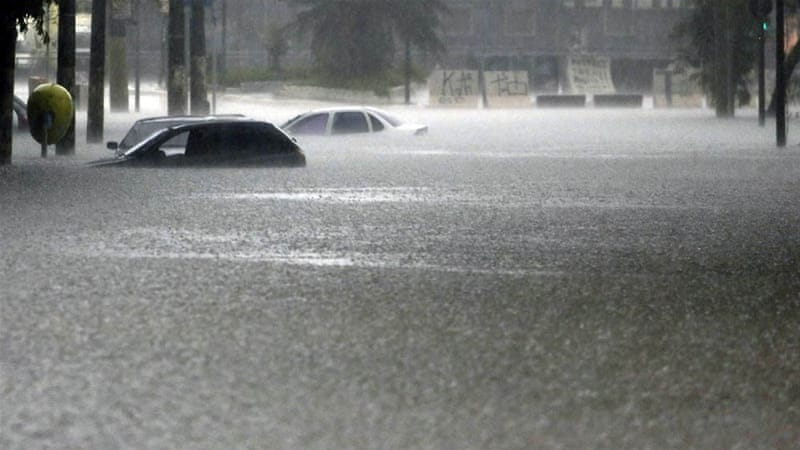From Harris County declared disaster area as death toll rises, city swamped, Chron, Updated May 26 9:48 PM:
With the water receding and more rains predicted, Karen Othon, spokeswoman for the Texas Department of Transportation Houston office, said road work remained a top priority.
"Crews will be out clearing debris on roadways and the inlets, as debris flowed by the water into the drains," Othon said. "This will be a continuing process over the next few days."
Those inlets are critical to keep many low-lying areas of the Houston freeway network open.
"The sun is shining out here right now and the city is slowly getting back to normal, but this is a little bit of a situation of a tale of two cities," Parker said. "Much of Houston was unaffected by the weather, but the parts that were affected by the weather were very severely hit. We've had 10 days, two weeks, of steady rain. The grounds were completely saturated and there's really been no place for the water to go."Does the part about clogged drains ring a bell? Think back....
Wait a minute; that's not Houston; that's Sao Paulo. Okay; lemme try again. No, that's Riyadh. Well, at least this resident was having fun in the desert city's freaky 2013 flood:
Here we are; this is Houston today:
They weren't the only kayakers out and about in the floodwaters and not all were joyriders; some were helping with rescues. The ones above were photographed by David J. Phillip for Associated Press. It's #8 in SF Gate's photo gallery of 55 pictures relating to the flooding in Texas today and yesterday. But an AP/SF 'live blogging' on the Texas flooding carried this warning:
3:20 p.m. CDT
A North Texas man has drowned when water being released from a dam overtook his kayak.
Chad Lorance with the Tarrant Regional Water District said Tuesday that 29-year-old Joshua Reed of Fort Worth was on the water with others when they disregarded signs Saturday and entered a restricted part of the Trinity River adjacent to the main dam for Eagle Mountain Lake.
Lorance says water was being released from the dam to prevent the lake from overflowing from recent rains.
'The Tarrant County medical examiner's office says Reed died of accidental drowning. Reed's body was recovered Sunday. He is among the nine weather-related deaths over the weekend in Texas.It was a very bad storm that struck central Texas, and it was as cruel to the rural regions as the cities and towns. But the mention of dam water being released to protect a lake brings me to many questions, questions about dams and reservoirs and modern cities (Houston is America's fourth largest city) and the 7,300+ dams in Texas, 60 percent of them privately owned. Questions for which I have no answers.
Yet I will tell you that a week before the storms first struck I came across a photo essay about the rainiest place on earth. The 18 photos are works of art. They were first published in The Atlantic August 22, 2014 under the title "Meghalaya: The Wettest Place on Earth" with this introduction by Alan Taylor:
Photographer Amos Chapple returns to our site once once again, bringing amazing images from the state of Meghalaya, India, reportedly the rainiest spot on Earth. The village of Mawsynram in Meghalaya receives 467 inches of rain per year. Laborers who work outdoors often wear full-body umbrellas made from bamboo and banana leaf.
One of the most fascinating and beautiful features in the region are the "living bridges" spanning rain-soaked valleys. For centuries, locals have been training the roots of rubber trees to grow into natural bridges, far outlasting man-made wooden structures that rot in just a few years. The bridges are self-strengthening, becoming more substantial over time, as the root systems grow.The village may be the rainiest place on earth but it's not really the wettest, if one thinks in terms of flooding. Although there are 'natural' reasons for this, Chapple's pictures illustrate that the people evolved ways to live in harmony with their surroundings. I think Mawsynram has valuable lessons to teach in that regard.
While the modern big city requires miles and miles of streets, sidewalks, plazas, and highway overpasses, it's written nowhere that the paving for these has to be virtually impermeable to the rains.
As I noted in Optical Illusion in Sao Paulo, no small part of the frequent flooding in that city is simply rainfall that can't soak into the ground -- and then the water, with no place to go, collects debris that clogs storm drains, creating even worse flooding. That's surely the same for virtually all other flood-prone modern cities. Which, it turns out, isn't a good thing for precious underground water resources because they need to be recharged by rainfall.
As I noted in Optical Illusion in Sao Paulo, no small part of the frequent flooding in that city is simply rainfall that can't soak into the ground -- and then the water, with no place to go, collects debris that clogs storm drains, creating even worse flooding. That's surely the same for virtually all other flood-prone modern cities. Which, it turns out, isn't a good thing for precious underground water resources because they need to be recharged by rainfall.
Permeable paving (aka porous asphalt and concrete) isn't a pie-in-the-sky idea; it's part of New York City's Green Infrastructure Plan (PDF), and not too long ago all paving -- brick and cobblestone -- were of course permeable constructions.
As to whether skyscrapers would be negatively impacted by large amounts of rain sinking into the ground near their foundations, I don't know. But I figure if engineers can make a river run uphill, as they did in California, there would be workarounds to any such problem.
As to whether skyscrapers would be negatively impacted by large amounts of rain sinking into the ground near their foundations, I don't know. But I figure if engineers can make a river run uphill, as they did in California, there would be workarounds to any such problem.
What we can't keep doing in this age of megapopulations is expecting extreme weather to conform to ideas of modernity created in an intellectual vacuum that excluded the natural world.
********



No comments:
Post a Comment